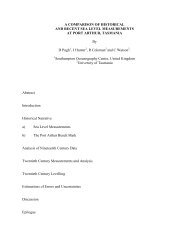Annual report 2005-06.indd - Antarctic Climate and Ecosystems ...
Annual report 2005-06.indd - Antarctic Climate and Ecosystems ...
Annual report 2005-06.indd - Antarctic Climate and Ecosystems ...
You also want an ePaper? Increase the reach of your titles
YUMPU automatically turns print PDFs into web optimized ePapers that Google loves.
antarctic marine ecosystemsof field data <strong>and</strong> models will be used topredict the effects of ecosystem changeson harvested species <strong>and</strong> the food web.This work will also be used in combinationwith credible models of fishery dynamicsto promote more effective management ofmarine living resources.OverviewMost marine life is found in the surface mixedlayer of the ocean, typically to about 200 metresdeep, where light from above <strong>and</strong> nutrients frombelow provide the foundations of productivity.Many of the vertebrate species (e.g., whales,seals <strong>and</strong> penguins) of the <strong>Antarctic</strong> region areof high conservation value <strong>and</strong> depend primarilyon <strong>Antarctic</strong> krill for food. The current inabilityto predict the effects of environmental changeson their populations makes it difficult for bodiessuch as the Commission for the Conservationof <strong>Antarctic</strong> Marine Living Resources (CCAMLR)<strong>and</strong> the International Whaling Commission(IWC) to establish sound long-term managementstrategies.Australian research has already highlightedthe structure <strong>and</strong> dynamics of the krill-basedSouthern Ocean ecosystem. Much of thisresearch has led to the adoption by CCAMLR,to which Australia is a signatory, of manyprecautionary proposals for managementof biological resources around <strong>Antarctic</strong>a.CCAMLR manages the krill harvest, which is the<strong>Antarctic</strong>’s largest fishery <strong>and</strong> the one with thegreatest potential to impact widely on the foodweb in the region. The krill fishery is projected toexp<strong>and</strong> into one of the world’s largest fisheries,yet the effects of climate change on krill stocks,<strong>and</strong> on the species dependent on krill (seabirds,penguins, seals <strong>and</strong> whales), are unknown.The ACE CRC is examining the predictedenvironmental changes <strong>and</strong> their implicationsfor sustainable management of SouthernOcean fisheries <strong>and</strong> the marine life protectedthrough CCAMLR. During the first two years,we developed a framework for elaboratingecosystem models of the Southern Ocean<strong>and</strong> created conceptual ecological modelsfor key taxa, including krill, in the <strong>Antarctic</strong>marine food web. We also analysed large-scaledatasets of ice <strong>and</strong> ocean colour to elaboratean empirical model of primary production in thesea ice zone of eastern <strong>Antarctic</strong>a <strong>and</strong> madesubstantial progress in developing under-icesensing capability to measure in situ chlorophyllabundance in the sea ice zone.Key achievements <strong>2005</strong>-06• Completion of BROKE-West Survey: TheBROKE-West expedition surveyed more than1 million square kilometres of the SouthernOcean, gathering data on krill populations<strong>and</strong> physical oceanographic properties.• Proposal for multidisciplinary sea ice studyin 2007: A 30-day early season cruise wasapproved by both the Physical Sciences<strong>and</strong> the Life Sciences <strong>Antarctic</strong> ResearchAssessment Committee (ARAC).• Sea ice algal distribution: A conceptual modelfor large-scale sea ice algal distribution wasdeveloped.• Krill population model: A spatially-structuredkrill population model based on empiricalmeasurements was developed for thesouthwest Atlantic.• Physical regionalisation of the SouthernOcean: Methods have been developed toassist in compartmentalising the ecosystemmodels as well as for providing a foundationfor reviewing the biological diversity in theSouthern Ocean.Plans for 2006-07• Testing of optical sensor (hyperspectralradiometer) for remote <strong>and</strong> non-invasivedetermination of ice algae distribution(Polarstern cruise).• Coordination of multidisciplinary sea icecruise (September 2007).• Scoping out the development of the fullycoupledbiophysical model.• Completion of the physical regionalisation ofthe Southern Ocean.• Further development of components ofa Southern Ocean ecosystem model,particularly model linkages between thephysical environment <strong>and</strong> krill productivity.• Analysis <strong>and</strong> publication of BROKE-Westresults.<strong>Antarctic</strong> <strong>Climate</strong> & <strong>Ecosystems</strong> CRC - <strong>Annual</strong> Report <strong>2005</strong>-06 37








